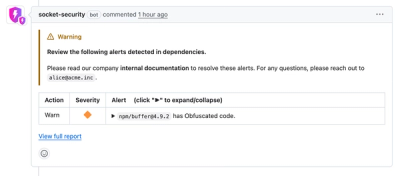
Security News
Crates.io Users Targeted by Phishing Emails
The Rust Security Response WG is warning of phishing emails from rustfoundation.dev targeting crates.io users.
A function that turns React hooks into HOCs for compatibility with class components

HOCify (H-oh-see-ify) is a simple library that converts hooks to HOCs for compatibility with class-based components.
Hooks are great! They're the React team's answer to many problems in React today. However, using them comes with a prerequisite:
Hooks can only be called inside the body of a function component.
This is unfortunate because it prevents us from using newer hook-based modules in our older class-based components.
This library aims to soften that prerequisite by giving you a reusable tool to convert some hooks into higher-order components.
Disclaimer: The purpose of "using hooks" within class components is more for compatibility of newer hook-based modules with older class-based components. If your component is already implemented as a function, then use the hook directly. If you're writing a new component, try writing it as a function component.
npm install --save hocify
hocify is a function that takes in a custom hook and returns an HOC.
⚠️️ There are a few things to note ️️️️️️⚠️
hocify is a hook and thus must follow the rules of hookshocify that uses these props as an input to other hooks.null. This object will be spread onto the input component as props.ExampleComponent.js
import React from 'react';
import hocify from 'hocify';
import useMyCustomHook from './useMyCustomHook';
// 1) create a custom hook to feed into HOCify.
// note: it's nice to have this top-level for the hooks linter to work correctly
// `props` are the incoming props of the resulting component
const useHocify = (props) => {
const result = useMyCustomHook(props.inputValue);
// 3) the resulting hook _must_ return an object OR `null`.
return { data: result };
};
const withMyCustomHook = hocify(useHocify);
class ExampleComponent extends React.Component {
render() {
const { data } = this.props;
}
}
export default withMyCustomHook(ExampleComponent);
ParentComponent.js
import React from 'react';
import ExampleComponent from './ExampleComponent';
function ParentComponent() {
// these props are the arguments to the inline hook in the `hocify` call above
// 👇👇👇
return <ExampleComponent inputValue="test" anotherProp={5} />;
}
export default ParentComponent;
hocifyThe following example shows how you can use two hooks with hocify. Note that it's better to create a combined custom hook over creating multiple HOCs.
import React from 'react';
import hocify from 'hocify';
import useHookOne from './useHookOne';
import useHookTwo from './useHookTwo';
const useHocify = () => {
const one = useHookOne();
const two = useHookTwo();
return { one, two };
};
// only create one HOC
const withHooks = hocify(useHocify);
class ClassComponent extends React.Component {
// ...
}
export default withHooks(ClassComponent);
The following example shows how you can use props in hocify(props => to react to prop changes. There is a useEffect in our example hook that will re-run if the id changes.
useFetchMovie.js
function useFetchMovie(id) {
const [movie, setMovie] = useState(null);
useEffect(() => {
async function getData() {
const response = await fetch(`/api/movies/${id}`);
const movie = await response.json();
setMovie(movie);
}
getData();
}, [id]);
return movie;
}
MyComponent.js
import React, { useState } from 'react';
import useFetchMovie from './useFetchMovie';
const useHocify = (props) => {
const movie = useFetchMovie(props.id);
return { movie };
};
const withFetchMovie = hocify(useHocify);
class MyComponent extends React.Component {
render() {
const { movie } = this.props;
// ...
}
}
export default withFetchMovie(MyComponent);
FAQs
A function that turns React hooks into HOCs for compatibility with class components
We found that hocify demonstrated a not healthy version release cadence and project activity because the last version was released a year ago. It has 1 open source maintainer collaborating on the project.
Did you know?

Socket for GitHub automatically highlights issues in each pull request and monitors the health of all your open source dependencies. Discover the contents of your packages and block harmful activity before you install or update your dependencies.

Security News
The Rust Security Response WG is warning of phishing emails from rustfoundation.dev targeting crates.io users.

Product
Socket now lets you customize pull request alert headers, helping security teams share clear guidance right in PRs to speed reviews and reduce back-and-forth.

Product
Socket's Rust support is moving to Beta: all users can scan Cargo projects and generate SBOMs, including Cargo.toml-only crates, with Rust-aware supply chain checks.